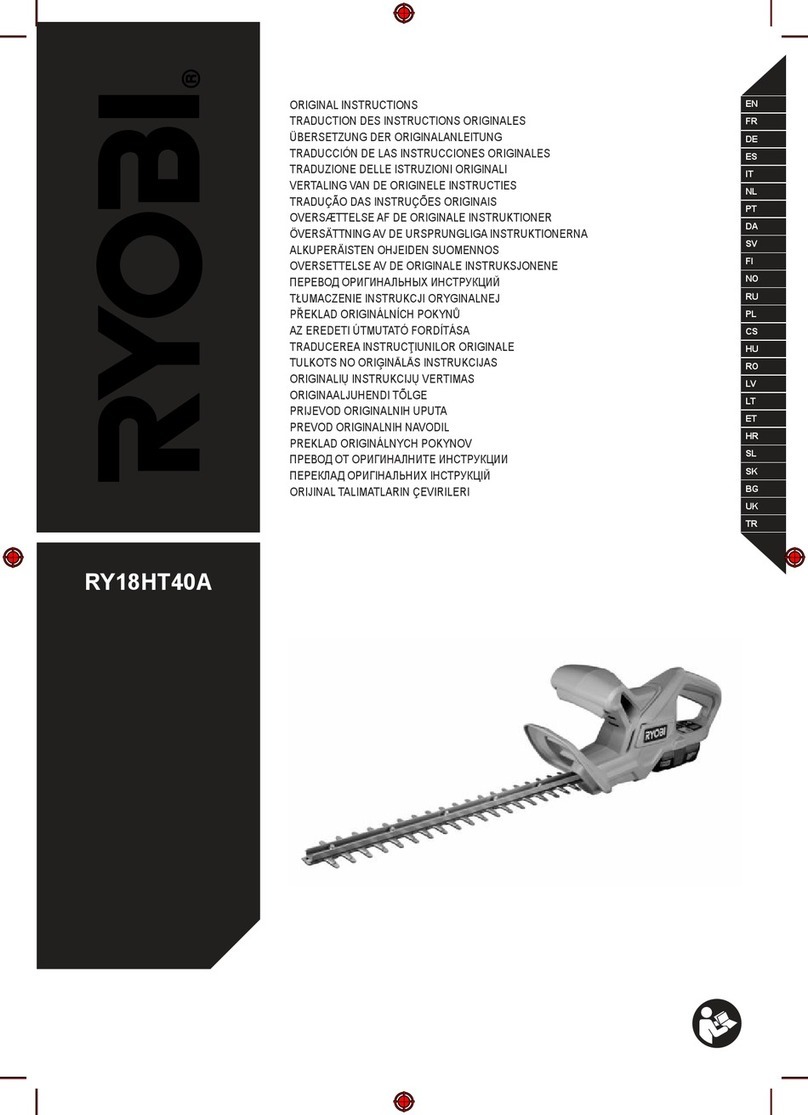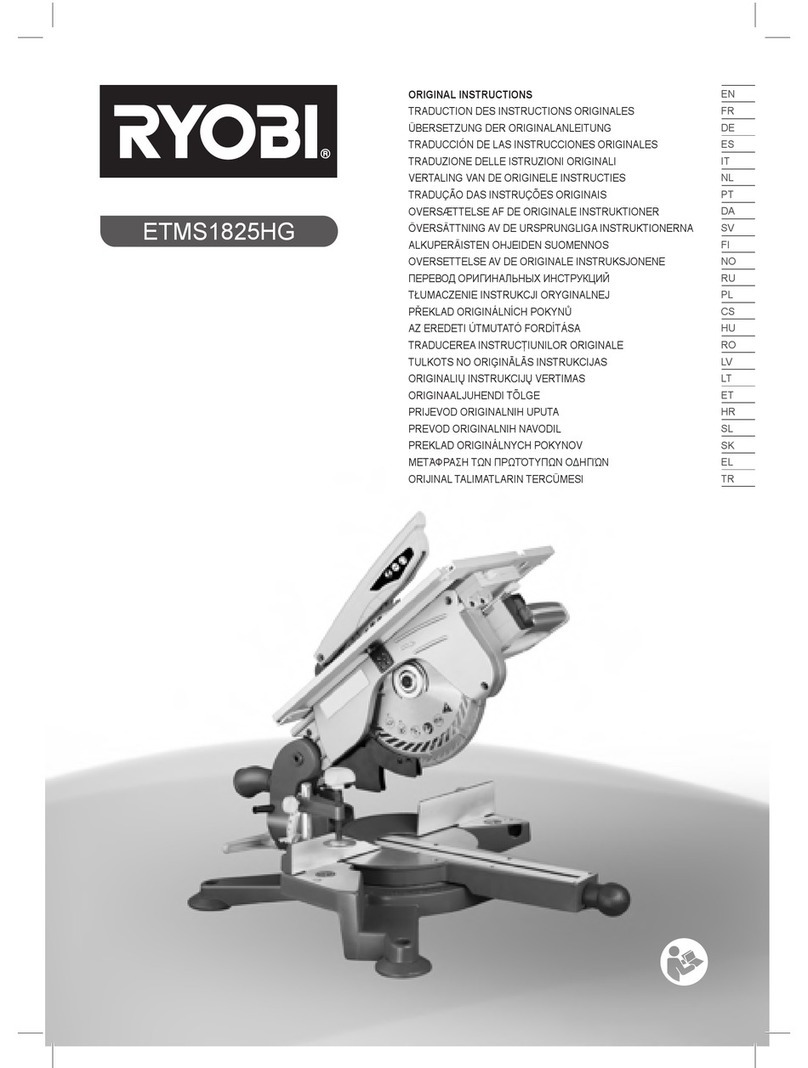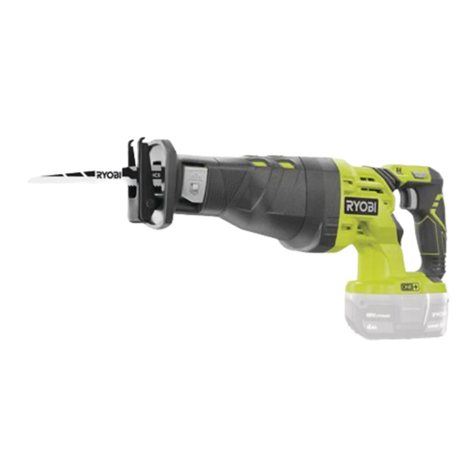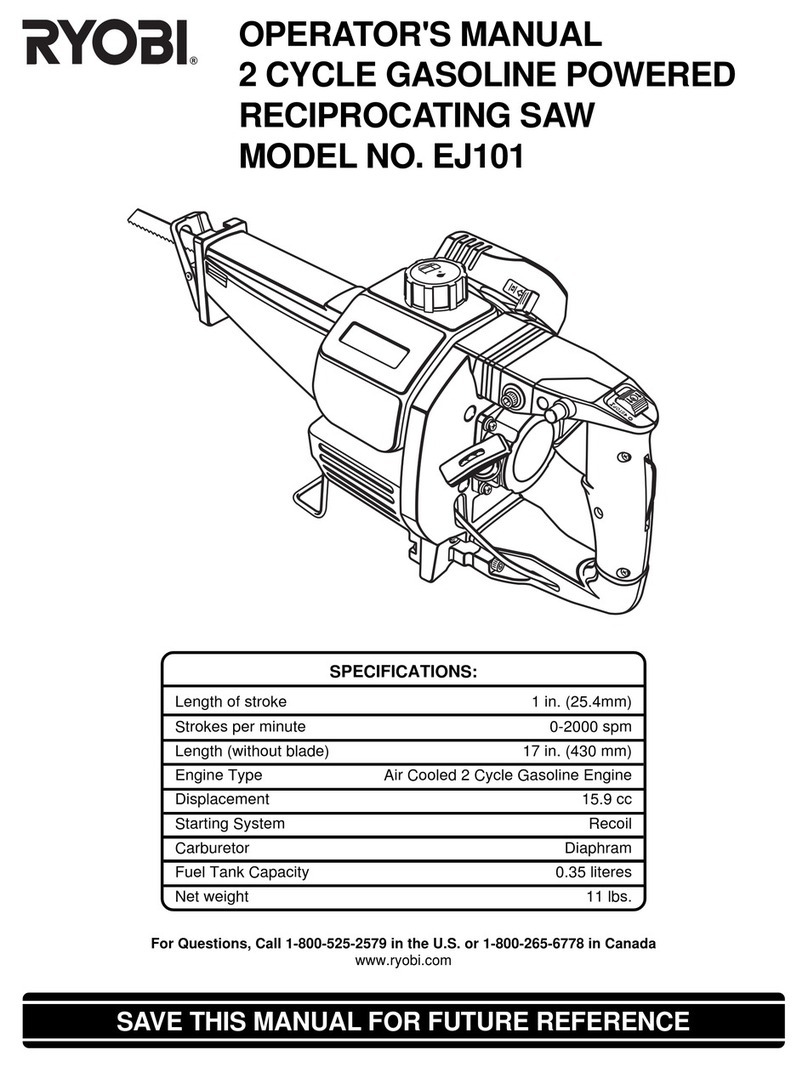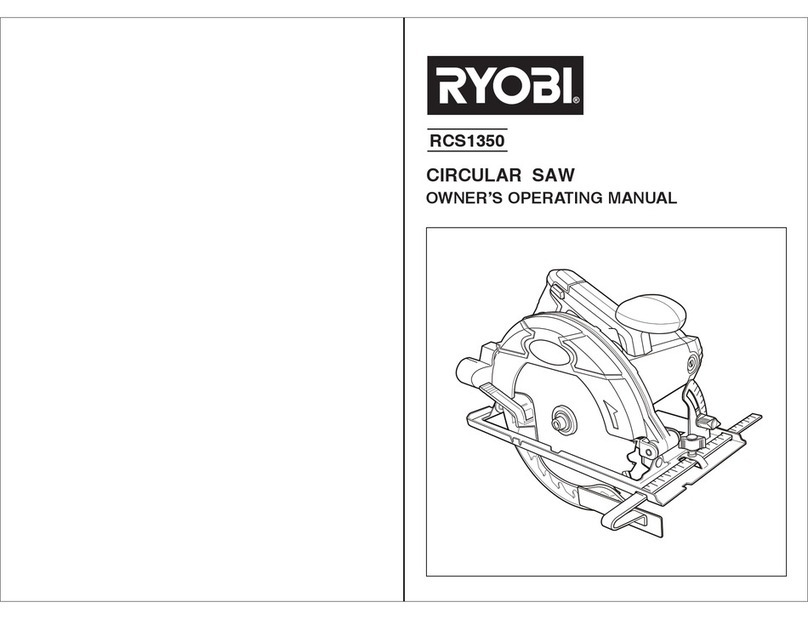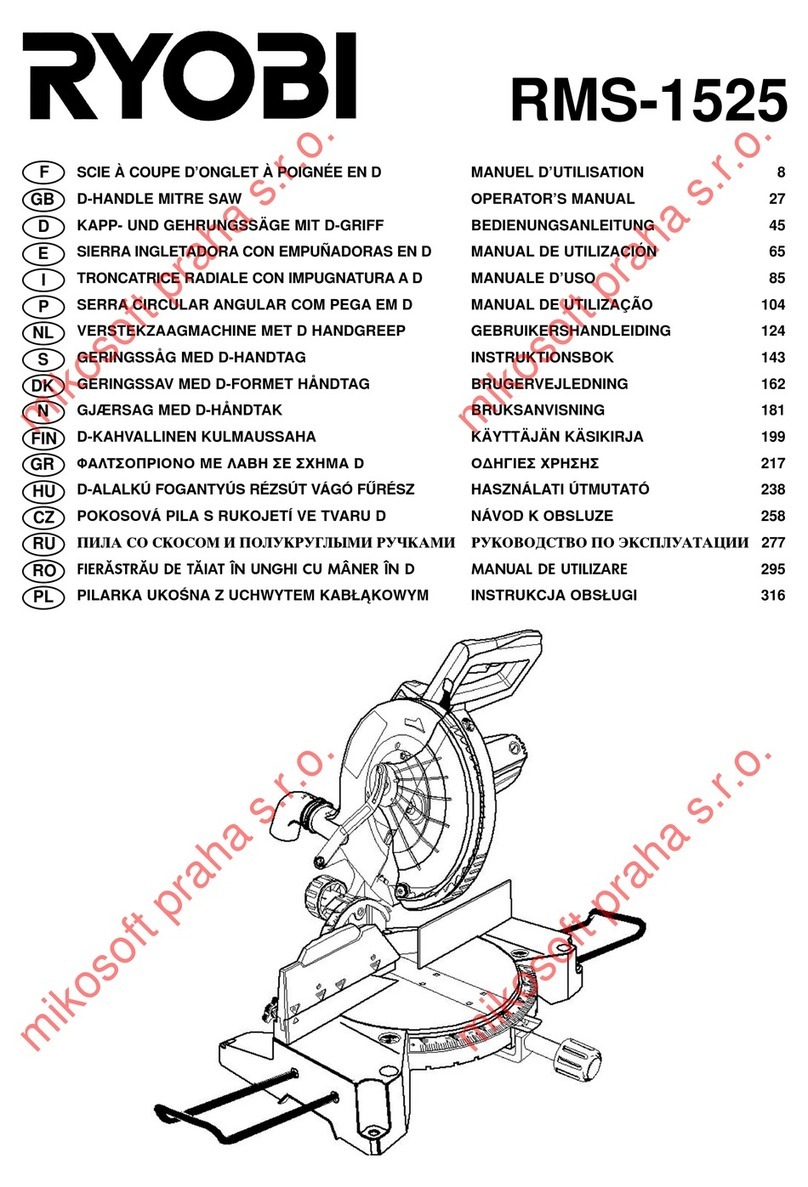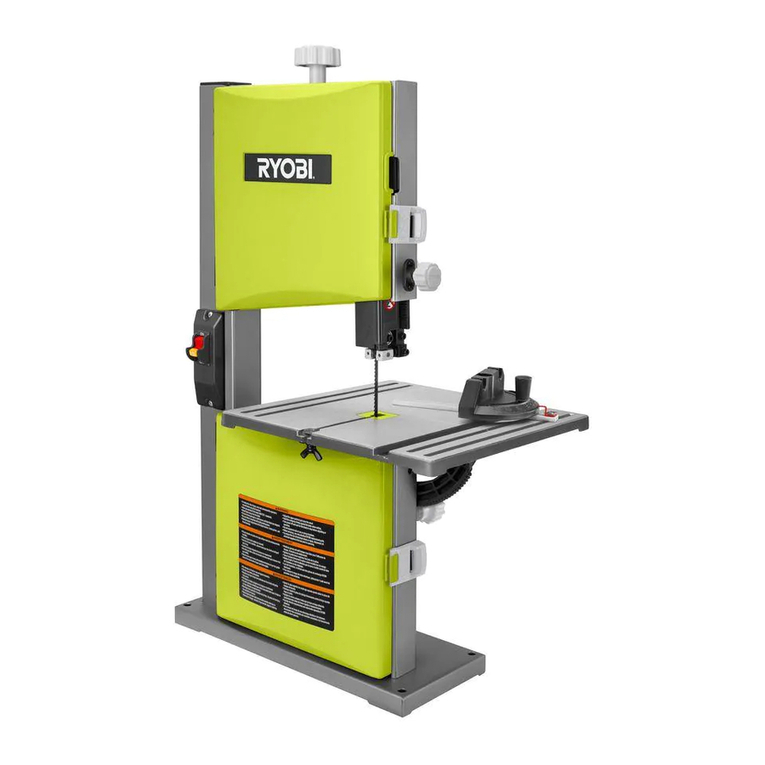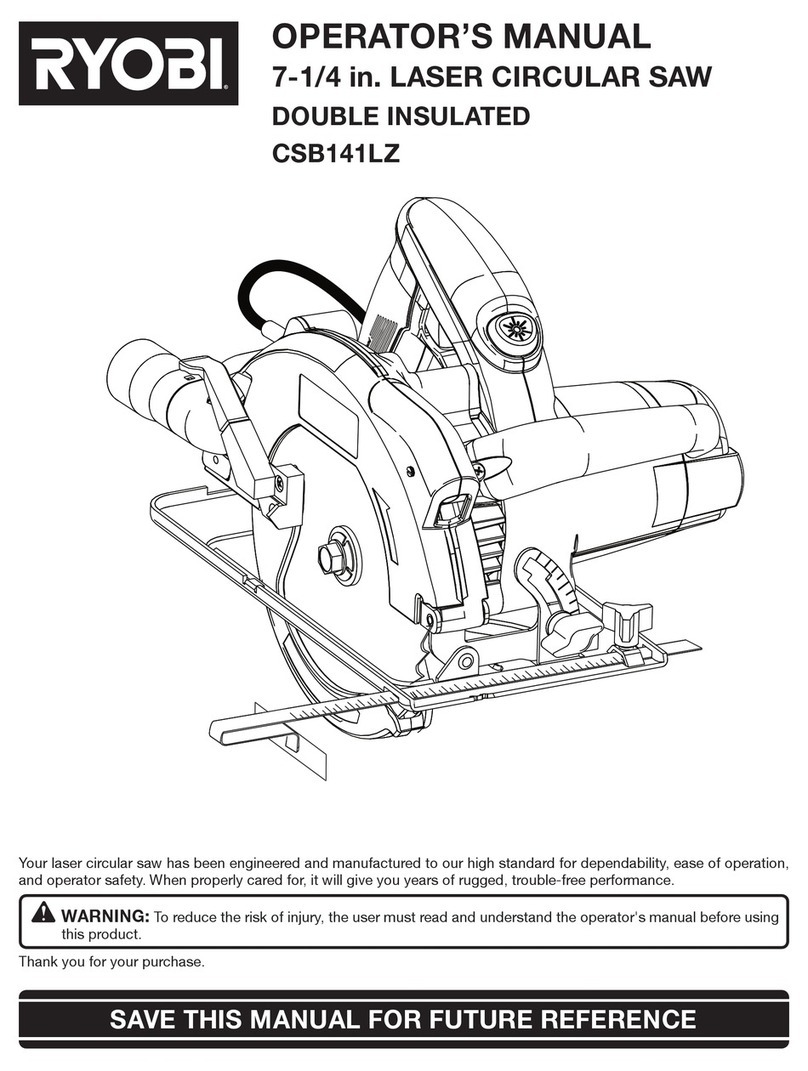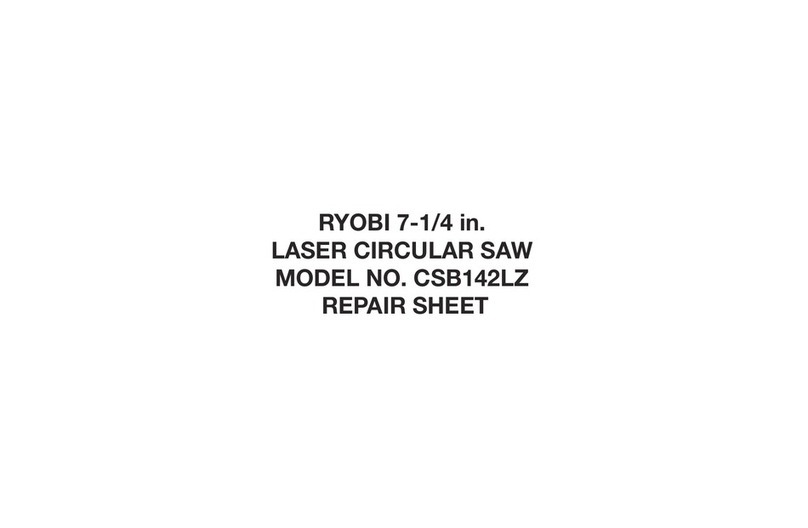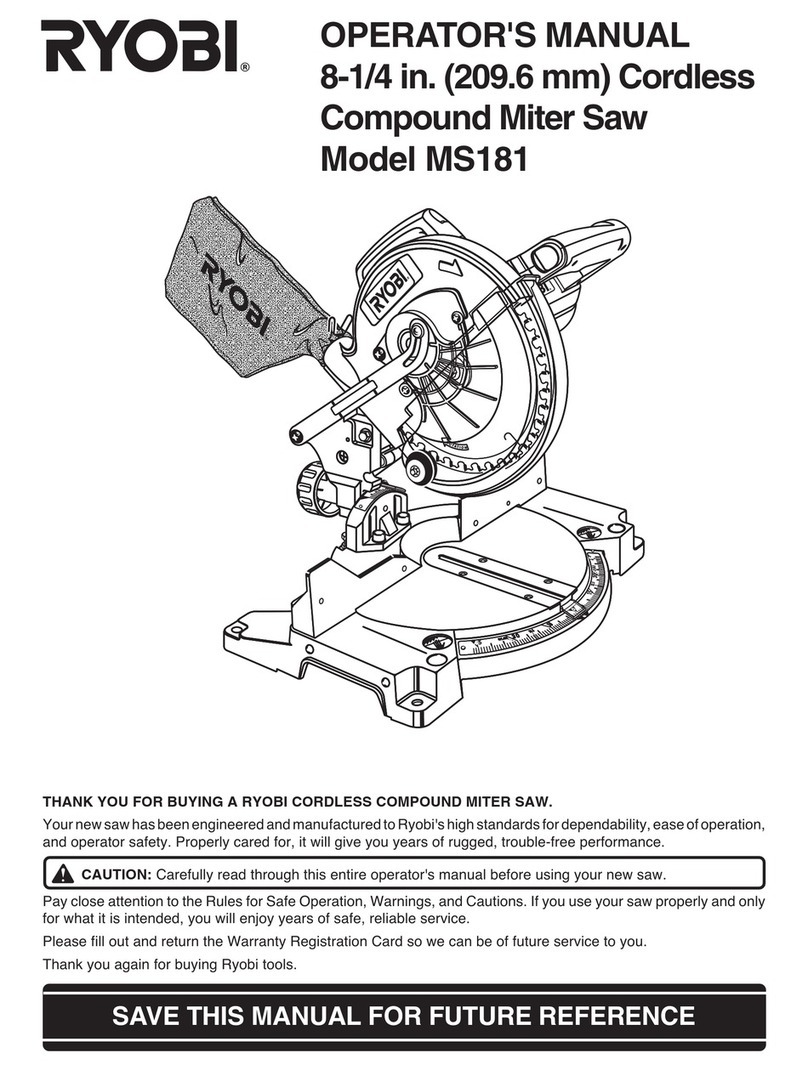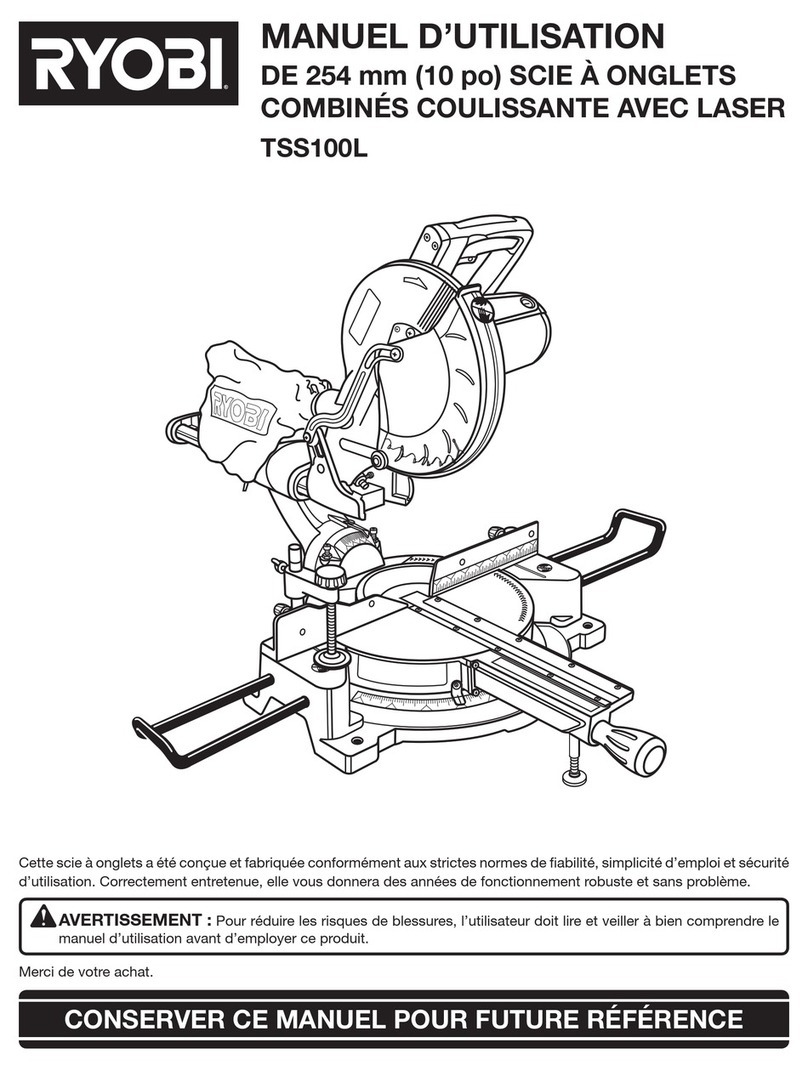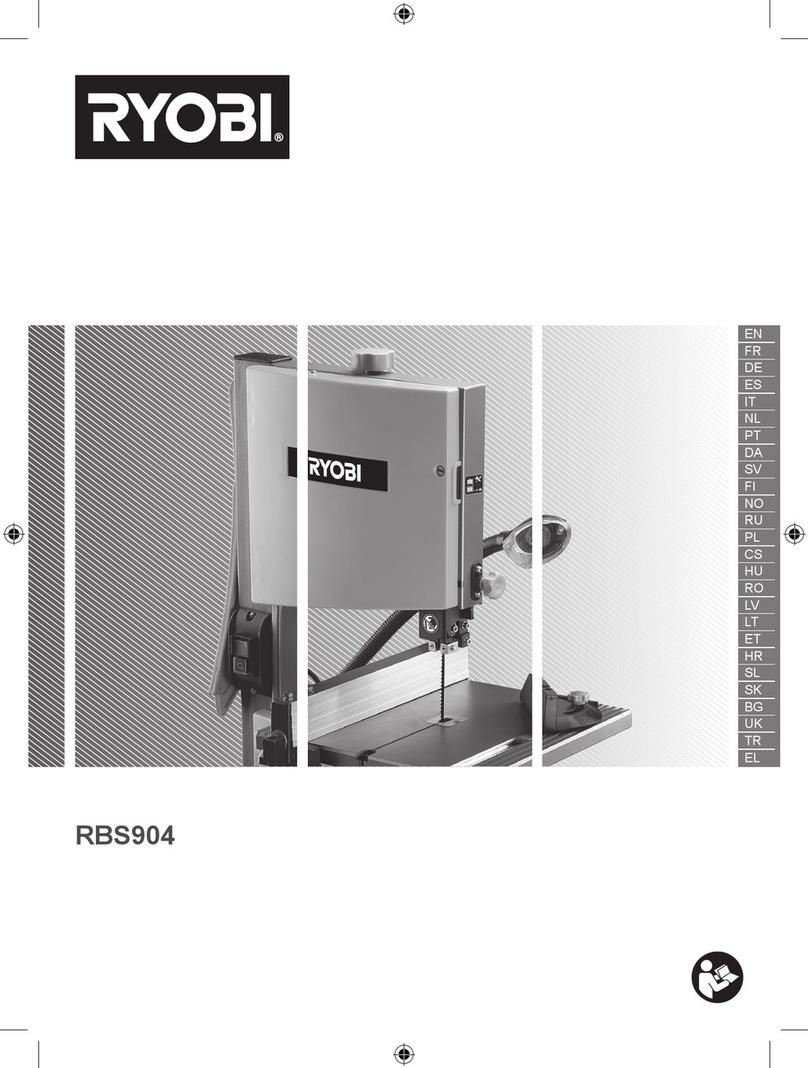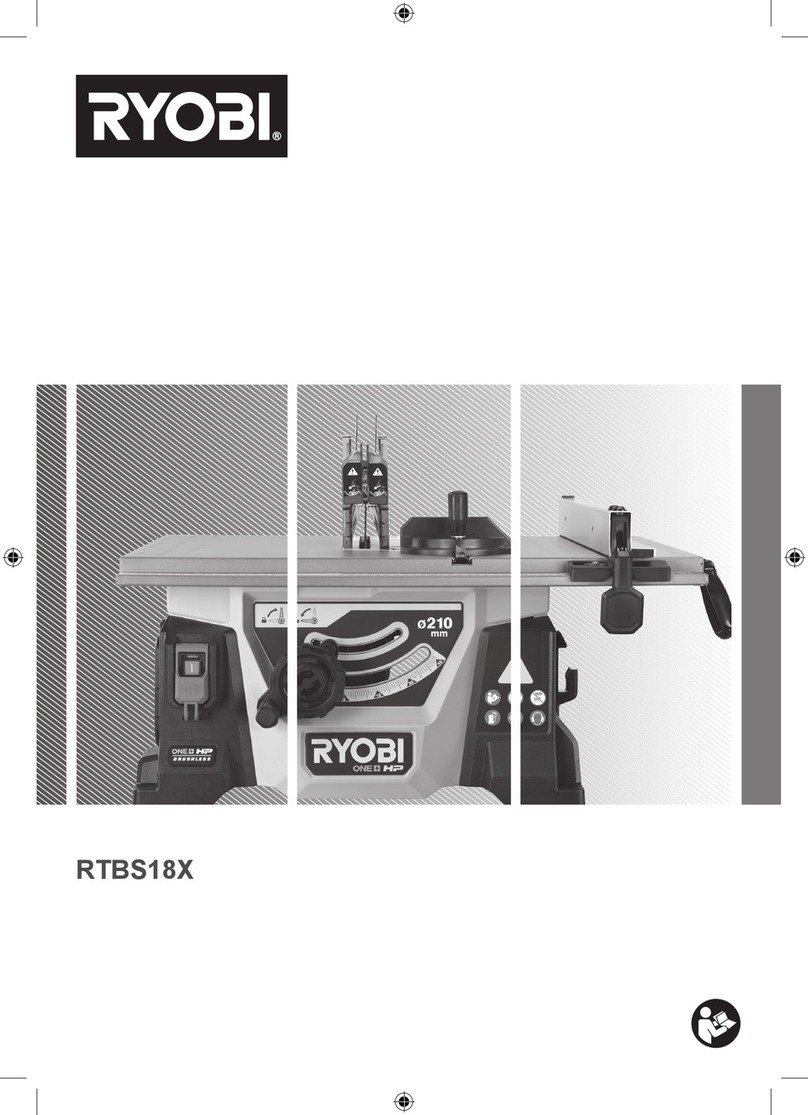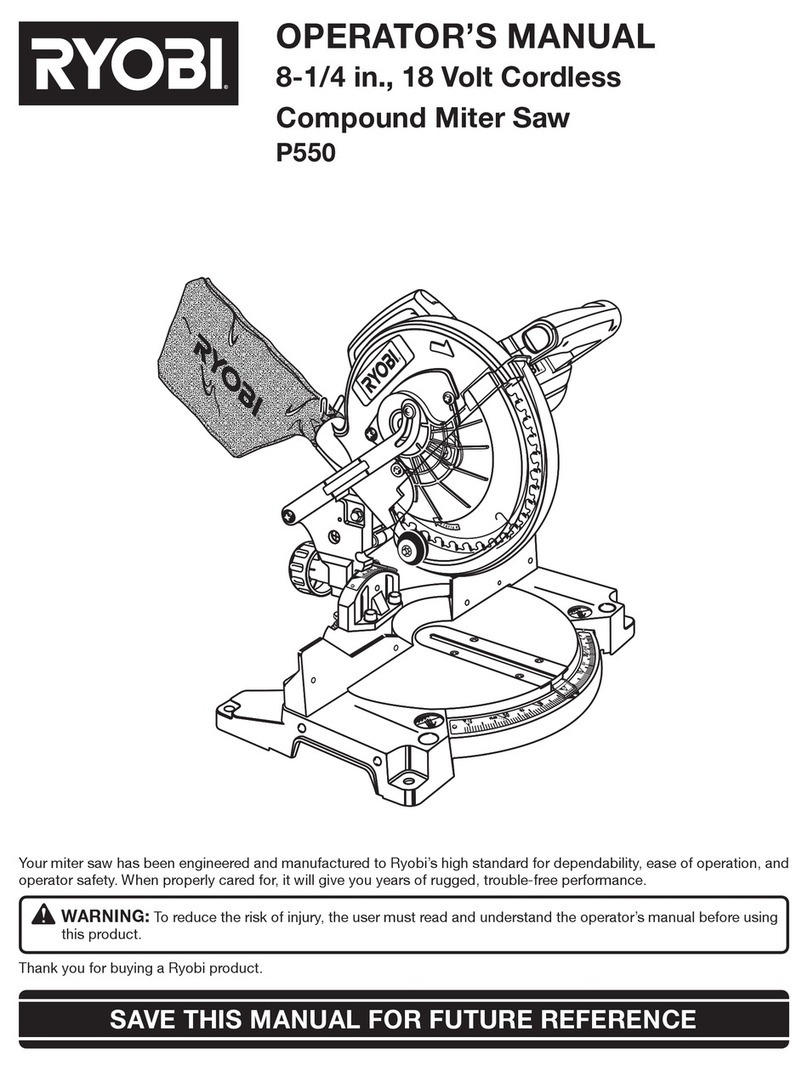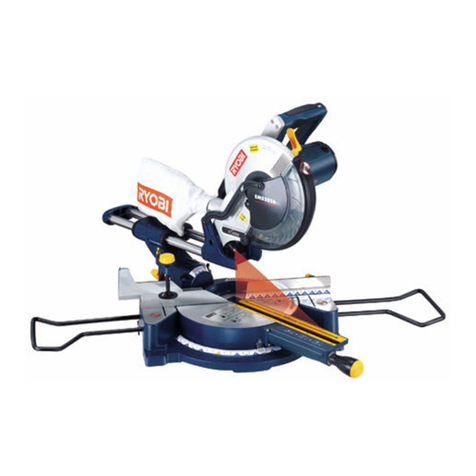
SafetySafety
32
■Damage to hearing if effective hearing protection is not
worn.
INTENDED USE
This machine is designed to rip and cross cut wood
exclusively up to maximum thickness of 80 mm.
For correct operation it must be xed and operated as
explained in this manual.
MAINTENANCE
Do not make any adjustments while the motor is in motion.
Always make sure the machines plug has been removed
from the mains power source before changing brushes,
lubricating or when doing any works or maintenance
on the machine. After each use, check your machine
for damage or broken parts and keep it in top working
condition by repairing or replacing parts immediately. Clean
out accumulated dust. To assure safety and reliability, all
repairs with the exception of externally accessible brushes
should be performed by an authorised service centre.
Faults in the machine, including guards or saw blades,
should be reported as soon as they are discovered.
ENVIRONMENTAL PROTECTION
Recycle raw materials instead of disposing
of as waste. The machine, accessories
and packaging should be sorted for
environmental-friendly recycling.
SYMBOL
Safety alert
V Volts
Hz Hertz
Alternating current
WWatts
noNo-load speed
min-1Revolutions or reciprocations per minute
CE conformity
Double insulation
Please read the instructions carefully before
starting the machine.
Wear ear protection
Wear eye protection
Danger! Sharp blade.
Waste electrical products should not be
disposed of with household waste. Please
recycle where facilities exist. Check with your
Local Authority or retailer for recycling advice.
ICONS IN THIS MANUAL
Unpacking
Getting started
Tools needed
Procedure search
Go to page #
Safety
Operation
Safety alert
Unplug
Information
Lock
Unlock
Waiting time
Wear safety hand gloves
changing the saw blade, make sure that the width of
the cut is wider than the body of the blade, which in turn
should not be wider than the thickness of the riving knife.
■It is necessary to select a saw blade which is suitable
for the material being cut.
■Wear suitable personal protective equipment when
necessary, this could include hearing protection to
reduce the risk of induced hearing loss, respiratory
protection to reduce the risk of inhaling harmful dust,
gloves when handling saw blades and rough material.
■Saw blades should be carried in a holder whenever
practicable.
■The dust produced when using this tool may be harmful
to health. Do not inhale the dust. Use a dust absorption
system and wear a suitable dust protection mask. Remove
deposited dust thoroughly, e.g., with a vacuum cleaner.
■Do not use saw blades made of high-speed steel.
■Use the push stick when required. Always use a push
stick for ripping narrow timber. The push stick should
always be stored with the machine when not in use.
■Always use the saw blade guard and riving knife for
every operation, including through sawing. Through
sawing operations are those in which the blade cuts
completely through the work piece when ripping or
cross-cutting.
■Cutting rebates or grooves is only permitted with a
suitable protective device fitted, e.g., a protective tunnel
over the saw table.
■Do not use circular saws for cutting slots (grooves in
work piece).
■Use only saw blades in which the maximum possible
speed is not less than the maximum spindle speed of
the tool and the material to be cut.
■When transporting the machine, use only transportation
devices and never use guards for handling or transportation.
■During transportation, the upper part of the saw blade
should be covered, for example, by the guard.
■Secure work. Use clamps or a vise to hold work when
practical. It is safer than using your hand and frees both
hands to operate the tool.
■Dust developing during operation can be harmful to
your health, inflammable or explosive. Never cut metals
or materials which may create hazardous dust.
■Always use in a well-ventilated area. Remove sawdust
frequently. Clean out sawdust from the interior of the
saw to prevent potential fire hazard.
■Keep the floor area free of loose material, e.g., chips
and cut-offs.
■Never leave tool running unattended. Turn power off.
Do not leave the tool until it comes to a complete stop.
■Do not modify the plug provided. If it will not fit the outlet,
have the proper outlet installed by a qualified electrician.
■Appliances used at many different locations including
open air should be connected via a residual current
device (RCD).
■Ground all tools. If the tool is equipped with three-prong
plug, it should be plugged into a three-hole electrical
receptacle.
■Never stand on tool. Serious injury could occur if the tool
is tipped or if the cutting tool is unintentionally contacted.
■Always keep the blade guard and riving knife in place
and in working order.
■Only use the saw with guards in good working order
and properly maintained, and in position.
■Always keep hands away from the path of the saw blade.
■Never reach into the danger area of the plane when it
is running.
■Feed the work piece into the blade or cutter against the
direction of rotation only.
■Remove adjusting keys and wrenches. Form the habit
of checking to see that keys and adjusting wrenches
are removed from the tool before turning it on.
■Always saw one work piece at a time. Sawing more
than one work piece at a time may jam the saw blade or
cause slipping of work pieces.
■Always use either the fence or the mitre gauge to
position and guide.
■When blade is running or when interrupting a cut, release
the trigger and hold the saw motionless until the blade
comes to a complete stop. Never attempt to remove the
saw from the work piece or pull the saw backward while
the blade is in motion or kickback may occur.
■Do not touch the saw blade immediately after sawing.
The saw blade gets hot during sawing.
■Do not use with any covers/guards removed.
■Use only saw blades recommended by the manufacturer.
■Always use the correct adjustment of the blade guard
and riving knife.
■Make sure the distance between the saw and the riving
knife is less than 5mm.
■The noise load is determined by the material to be
sawed as well as the saw blade type.
■Troubles in the machine, including the protective equipment
and the saw blade, are to be reported to the person
responsible for the safety once they are discovered.
RESIDUAL RISKS
Even when the machine is used as prescribed, it is still
impossible to completely eliminate certain residual risk
factors. The following hazards may arise in connection with
the machine’s construction and design:
■Contact with the saw blade in the uncovered saw zone.
■Reaching into the running saw blade (cut injuries).
■Kick-back of workpieces and parts of workpieces due to
improper handling.
■Saw blade fracturing.
■Catapulting of faulty carbide tips from the saw blade.
■Damage to lungs if effective dust mask is not worn.


